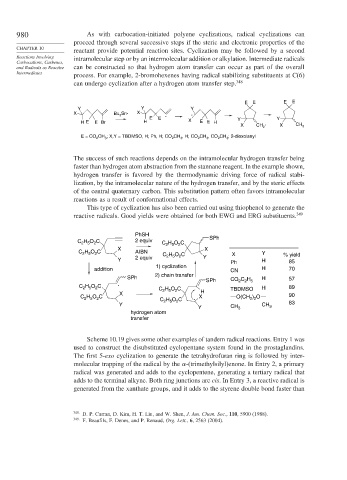Page 1004 - Advanced Organic Chemistry Part B - Reactions & Synthesis
P. 1004
980 As with carbocation-initiated polyene cyclizations, radical cyclizations can
proceed through several successive steps if the steric and electronic properties of the
CHAPTER 10
reactant provide potential reaction sites. Cyclization may be followed by a second
Reactions Involving intramolecular step or by an intermolecular addition or alkylation. Intermediate radicals
Carbocations, Carbenes,
and Radicals as Reactive can be constructed so that hydrogen atom transfer can occur as part of the overall
Intermediates
process. For example, 2-bromohexenes having radical stabilizing substituents at C(6)
can undergo cyclization after a hydrogen atom transfer step. 348
E E E E
Y Y Y
X Bu Sn . X .
3 .
E E Y Y
H E EBr H X E E H .
X CH 2 X CH 3
CH ; X,Y = TBDMSO, H; Ph, H; CO CH , H; CO CH , CO CH ; 2-dioxolanyl
E = CO 2 3 2 3 2 3 2 3
The success of such reactions depends on the intramolecular hydrogen transfer being
faster than hydrogen atom abstraction from the stannane reagent. In the example shown,
hydrogen transfer is favored by the thermodynamic driving force of radical stabi-
lization, by the intramolecular nature of the hydrogen transfer, and by the steric effects
of the central quaternary carbon. This substitution pattern often favors intramolecular
reactions as a result of conformational effects.
This type of cyclization has also been carried out using thiophenol to generate the
reactive radicals. Good yields were obtained for both EWG and ERG substituents. 349
PhSH
SPh
C H O C 2 equiv C H O C
2 5
2
2 5
2
X X
C H O C AIBN C H O C X Y
2
2 5
2 equiv 2 5 2 Y % yield
Y Ph H 85
1) cyclization
addition CN H 70
2) chain transfer
SPh SPh CO 2 2 5 H 57
C H
C H O C . H 89
2
2 5
H O C
C 2 5 2 H TBDMSO
X 90
C H O C C H O C . X O(CH ) O
2 2
2
2 5
Y 2 5 2 CH CH 3 83
Y 3
hydrogen atom
transfer
Scheme 10.19 gives some other examples of tandem radical reactions. Entry 1 was
used to construct the disubstituted cyclopentane system found in the prostaglandins.
The first 5-exo cyclization to generate the tetrahydrofuran ring is followed by inter-
molecular trapping of the radical by the -(trimethylsilyl)enone. In Entry 2, a primary
radical was generated and adds to the cyclopentene, generating a tertiary radical that
adds to the terminal alkyne. Both ring junctions are cis. In Entry 3, a reactive radical is
generated from the xanthate groups, and it adds to the styrene double bond faster than
348 D. P. Curran, D. Kim, H. T. Liu, and W. Shen, J. Am. Chem. Soc., 110, 5900 (1988).
349
F. Beaufils, F. Denes, and P. Renaud, Org. Lett., 6, 2563 (2004).

